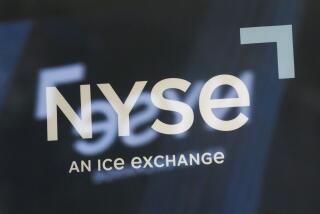Gold, Mixed Abroad, Falls Sharply in U.S.
- Share via
NEW YORK — Gold and silver prices fell sharply in the United States on Monday after a mixed showing overseas.
Republic National Bank in New York quoted gold at $313 an ounce, down $7 from Friday’s late bid.
The dollar, which had dropped sharply in value in early European activity, recovered in U.S. trading. The early declines in the dollar were touched off by the cut in the Federal Reserve Board’s discount rate late last Friday and a broad decline in the prime lending rate.
Gold began the day in Hong Kong by edging up $1.34 to bid $324.76 an ounce.
In London, gold slipped to $321.00 an ounce from $322.00. In Zurich, bullion edged down to $322.25 from $322.50 an ounce.
But the metal’s decline gathered momentum at the Commodity Exchange in New York, and gold for current delivery lost $6.90 to $313.20 an ounce.
Advance Stalled
Silver was unchanged at $6.51 an ounce in London, but, on New York’s Comex, silver for spot delivery tumbled 39.9 cents to $6.093 an ounce.
Jack Boyd, precious metals analyst at Drexel Burnham Lambert, said that gold and silver prices opened higher but that the advance quickly stalled, prompting disappointed traders to then sell the metals. The decline in gold and silver then accelerated as the dollar strengthened, he added.
The dollar skidded in Europe following the Federal Reserve’s cut in its discount rate to 7.5% from 8%. Most major American banks accompanied the Fed’s action by lowering their prime, or base, lending rates by half a point to 10%.
The lower rates reflected recent declines in money-market interest rates and the sluggishness of the U.S. economy’s expansion, both of which were seen as potential bearish trends for the dollar.
In European markets, the dollar’s slide knocked more than 4 pfennigs off its value against the West German mark and more than 15 centimes against the French franc. There are 100 pfennigs and centimes in the mark and franc, respectively.
But demand for the dollar increased as trading moved to the United States, largely because the drop in American lending charges is seen fueling a rebound in the economy, dealers said.
“The lower discount rate knocked the dollar down, but now the thinking is that we will start to see U.S. economic growth pick up and that the United States will still be an attractive place to keep money,” said Ronald Holzer, chief dealer at Harris Trust & Savings Bank in Chicago.
More to Read
Inside the business of entertainment
The Wide Shot brings you news, analysis and insights on everything from streaming wars to production — and what it all means for the future.
You may occasionally receive promotional content from the Los Angeles Times.










